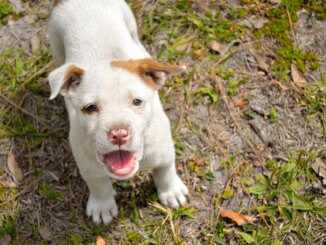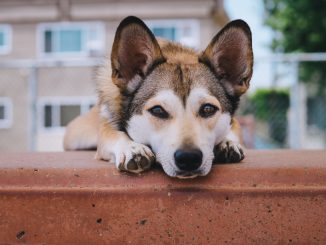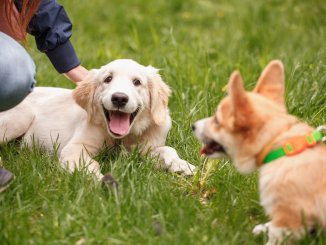The corgi is a medium-sized herding dog of Welsh origin. These dogs are also commonly referred to as Welsh corgis, which include the two breeds of this dog, the Pembroke Welsh corgi, and the Cardigan Welsh corgi. Pembroke Welsh corgis also go by Pems and Pembrokes.
This breed ranges from 10 to 12 inches tall and weighs between 24 and 30 pounds. Welsh corgis have a friendly, outgoing personality and are unaggressive. They live 12–14 years and make wonderful family pets.
Purebred Pembroke and Cardigan corgis are low-maintenance, apart from their ever-shedding coats. Impure mixes are prone to unwanted genetic conditions, and the dogs typically suffer from separation anxiety if left alone too long.
Purebreds cost between $250 and $3,000.
TABLE OF CONTENTS
Corgi Characteristics & Overview

From Adobe Stock
| Common names: | Corgis, Welsh corgis, Pembroke Welsh corgis (Pems, Pembrokes), Cardigan Welsh corgis |
| Origin: | Wales |
| Breed group: | Herding dog |
| Size: | Medium |
| Height: | 10–12 inches |
| Weight: | 24–30 pounds |
| Colors: | Red, sable, fawn, tan & black, some with white flashings |
| Coat: | Double coat, short length |
| Life expectancy: | 12–14 years |
| Temperament: | Bold, friendly, protective, outgoing, playful |
| Shedding: | Heavy shedders |
| Barking tendency: | High |
| Cost: | $250–$3,000 |
Origin & Purpose
Corgis originate from Pembrokeshire, Wales, and the dog breed has a history stemming from folklore and mystery. Welsh legends speak of the breed originating from the dens of fairies and elves. One historical theory says that the breed came from Vikings in the ninth and 10th centuries.
The Cardigan Welsh corgi descends from the Swedish cattle dog in Vallhunds. Pembroke Welsh varieties may have descended from Vallhunds or from the Flemish weavers who came to Wales in the 12th century.
Both breeds were herding dogs on farms before being recognized by the UK Kennel Club in the 1920s, and by the American Kennel Club in 1934. Pembrokes and Cardigans were classified as the same breed in 1925, whereas they were considered different breeds in the early 1920s.
Owners weren’t satisfied that judges preferred one or the other type, so they voiced their concerns to have Pembrokes and Cardigans registered as two different dogs by the Kennel Club in 1934.
Both breeds are still used as herding dogs, but they’re mainly family dogs today.
Lifespan
Corgis live, on average, 12–14 years. Buying from reputable breeders that test for genetic conditions, like hip dysplasia and cutaneous asthenia, ensures a longer lifespan. Dogs from pet stores or puppy mills have a higher risk of genetic disorders and a shorter lifespan.
Corgi Appearance

From Adobe Stock
Corgis are short dogs with double coats that shed a lot. Their coat is thick and coarse with rare, softer varieties.
Their standard colors include tan, black, and fawn, while rare colors include red merle, and sable. These dogs look like cute foxes with stumpy legs and a notably deep chest that protrudes between the forelegs.
Height and Weight
Corgis are considered medium-sized dogs, with a height at the withers of 10–12 inches, and a weight of 26–30 pounds for males. Females average a height at the withers of 10 inches and weigh 24–28 pounds.
Puppies, at eight weeks, weigh around 8 pounds and they gain a pound a week until they’re mature.
Cardigans are taller and heavier than Pembrokes.
Colors
Corgis are typically fawn, red, sable, or black and tan. Some have white markings on their coats, commonly on the legs, neck, belly, muzzle, chest, and a narrow blaze on the forehead. The different colors for this breed look as follows:
Black & Tan
Black and tan corgis have a dark brown or black back, between the withers and tail. This color variety has tan markings on its sides, and the inner ears and around the eyes have tan coloring. Black and tan is typical coloration for Pembrokes.
Fawn
Fawn-colored individuals have a white belly, muzzle, and chest, with a pure fawn color over the ears and between the withers and tail. These dogs have a narrow blaze of white on their heads and dark brown eyes. Fawn coloration is typical among Pembrokes.
Sable
Bluish or gray markings with a marbled effect are a rare coloration called “sable.” The sable-colored dogs have a widow’s peak or black marking that arches over their eyes. These dogs often have extremely light blue or gray eyes. Sable is more common with Cardigans.
Red Merle
A red merle corgi, also known as a liver merle corgi, is missing a pigmentation gene. This dog has a solid red-looking coat on the back and top of the legs. The red color looks like a deep brown. Red merle varieties have light blue or gray eyes. Red merle is common with Cardigans.
Coat
Corgis have a double coat of short, thick, weather-resistant outer coat. The undercoat has a coarse feel, and is shorter than the outer coat. These dogs have thicker and rougher hair around the neck. Their coat is also longer and fuller around the hind legs and forelegs.
This breed’s fur is smooth and straight, yet it typically has a “fairy saddle” over its back, caused by the thickness and direction of a hairy strip. Furry dogs are rare finds in a litter, and the longer, softer coat is desirable by families but not by show experts.
This breed sheds a lot because of its thick and coarse coat. These dogs shed excessively twice a year when seasons change from hot to cold and vice versa.
Head
Corgis have a broad, fox-shaped head with bat-shaped ears with a flat surface between them. They are characterized by their round cheeks and long neck.
Personality and Temperament

From Adobe Stock
Pembroke corgis are friendly, loving, confident, and outgoing. Pembrokes aren’t shy or aggressive, and they enjoy training and socializing with people. Cardigans exude a loyal and affectionate personality with unaggressive traits.
Both breeds are intelligent and affectionate and need lots of attention. They make the perfect family dogs if people spend a lot of time with them. They also get along with cats and other dogs in the home if they grow up together.
Barking
These dogs have a high tendency to bark at everything if they’re not socially trained. Exposing puppies frequently to new places, people, and pets from weeks seven to 17 will naturally improve their social training.
Corgi Care
Corgis are easy to care for if their food is managed and grooming needs are met. They also require ample exercise to keep them happy.
Food Needs
Corgis tend to overeat, and their nutritional needs should be managed to avoid obesity. Corgis should be fed 3/4 cup of dry dog food two meals daily. Wellness Complete Health Dry Dog Food and Taste of the Wild Dry Dog Food are excellent choices.
Canned or wet dog food isn’t recommended because these dogs won’t know when to stop eating. Give them only one tablespoon of canned dog food twice a week as a treat.
Grooming Needs
Welsh corgis are shedders, and even worse seasonal-change shedders. They require frequent grooming during seasonal changes. Comb them daily with a slicker brush, and bathe your dog once weekly in early summer or late spring to loosen the hair.
Exercise Needs
Corgis have limitless energy and benefit from moderate exercise daily to sustain their mental and physical health. They excel with jogging, walking, tracking, and agility exercises followed by plenty of water to drink.
These dogs don’t thrive in townhouses or apartments where there isn’t room to run. However, daily exercise helps them thrive in smaller living spaces or those without gardens.
Mental Needs
Corgis are intelligent yet emotional, and they need daily mental stimulation to avoid unwanted behavior like chewing furniture or barking. They suffer easily from separation anxiety and should never be left alone all day.
Having another pet at home can help keep your dog happy, or ask someone to spend time with it when it’s alone. Stimulating this breed with playtime also works wonders for its mental health.
Playing fetch, tug-of-war, swimming, or herding tennis balls are excellent playtime activities.
Toys also provide mental stimulation. Some great choices include:
Common Health Concerns
Corgis are prone to a few health conditions if the breed is impure or the dog’s diet isn’t managed well. A healthy, balanced diet prevents obesity and diabetes, and any genetic disorder can be avoided by requesting proof of screening conducted on the breeding pair from a reputable breeder.
The most common disorders include:
Cutaneous Asthenia
Cutaneous asthenia is a genetic condition caused by a lack of collagen in the skin. Corgis of any age are at risk, and signs and symptoms include the dog’s skin becoming loose, fragile, painful, and stretchy. Dogs with cutaneous asthenia require prompt veterinary treatment.
Cystinuria
Cystinuria is a genetic disorder common in male corgis of any age and is characterized by kidney stones in the urinary tract that lead to frequent, painful, bloody, and strained urination. Immediate veterinary care is recommended when these symptoms appear.
Prevent cystinuria by feeding your dog low-protein diets like Hill’s Science Diet.
Epilepsy
Pembrokes of any age are prone to epilepsy as a genetic disorder, and also as a non-inherited disorder that can result from low blood sugar, tumors, strokes, or other trauma. Epilepsy’s most common symptom is seizures. Your dog will require a vet’s diagnosis then lifelong medication to control the seizures.
Patent Ductus Arteriosus (PDA)
Corgis are at increased risk for PDA, a genetic disorder affecting puppies. An affected puppy’s heart doesn’t pump oxygenated blood into the lungs. Vets typically diagnose puppies with PDA upon their first examination. The defect is a quick surgical fix.
Von Willebrand’s Disease
Von Willebrand’s disease is a commonly inherited blood-clotting disorder in corgis. The dog suffers from frequent nose bleeds, bleeding gums, and wounds that won’t heal. A vet can perform a diagnosis with a complete blood test and will likely prescribe a lifestyle change.
Dogs with Von Willebrand’s disease require blood transfusions before surgery and cauterized injuries to stop the bleeding, and vet-recommended medications to prevent bleeding.
Cataracts
Corgis are prone to cataracts as they get older. Cataracts appear as cloudy opacities over the lens. Trauma and diabetes caused by obesity can also lead to cataracts. Surgical removal of the cataracts by a veterinarian is recommended once cataracts set in.
Degenerative Myelopathy (DM)
DM is a genetic condition affecting older corgis. It’s a progressively degenerative disease affecting the nervous system along the spine and hindquarters. Dogs become weak in the rear and lose their bladder control.
Symptoms of DM include scraping nails, exaggerated movements, and stumbling. There’s no treatment, but your vet can provide a care routine and suggest walking wheels to keep your dog mobile.
Hip Dysplasia
Corgis are prone to genetic hip dysplasia, resulting in arthritis as the dog grows older. Symptoms and signs of hip dysplasia include weakness around the joints, discomfort, snappy behavior, and pain.
An x-ray is the best diagnosis. Detect hip dysplasia early by asking your dog’s breeder for information on the health of the dog’s parents. Pain treatment is the only option for affected dogs.
Progressive Retinal Atrophy (PRA)
PRA is a common occurrence in older, mixed-breed corgis. The retina develops abnormally, causing the dog first to lose night vision, followed by day-blindness. Vets conduct a general ophthalmic examination and prescribe supplements to reduce retinal stress.
Keep the home environment consistent to help your dog adapt to progressive blindness.
Training
Corgis are a pleasure to train because of their loyal natures and willingness to please. They are also intelligent and sometimes independent dogs, with a mind of their own. Training should begin at seven weeks, especially for house and social training and bark control.
Both older and young dogs of this breed respond well to obedience training to learn basic commands, and puppies do best with clickers and positive reinforcements. Other worthwhile and affordable options include puppy training schools, such as free at-home courses for owners while the puppy trains at school.
Corgi Price
Corgis range from affordable puppies to expensive purebreds with low risks of genetic disorders. Adopting this breed is the most affordable option, and adoption agencies also offer purebreds.
How Much Is a Corgi?
A corgi typically costs $250 to $3,000. The prices vary according to the breeder, history, color, age, and whether the dog is adopted or not. Adopted dogs cost $250 for adults and up to $600 for puppies that need more vaccinations and sterilization.
Some breeders and pet stores sell these dogs from $600 to $1,000 each without a guarantee of good genetic bloodlines. Purebred, show-quality AKC-registered dogs from reputable breeders willing to prove healthy genetic bloodlines cost between $2,000 and $3,000 for a puppy.
How Much Does it Cost to Own a Corgi?
Corgis aren’t expensive to maintain. They cost on average $100 to $300 monthly for their food, grooming, treats, and chew toys. Annual vet checkups and vaccinations cost $120 to $160 if no genetic health conditions are diagnosed. Additional vet visits cost $100 on average.
Is This Breed Right for You?
Corgis are amazing dogs with adorable, agreeable, and social traits. This breed has special requirements for living healthily and needs certain environments to thrive. They work better with some people than others because of their herding tendencies.
Who Should Get a Corgi?
Corgis are suitable for families with older children and, if the dog is socialized, homes with other pets. This breed needs social interaction, attention, and loads of exercise. The dogs flourish in apartments, townhouses, and the countryside, as long as they get loads of exercise, with a daily, structured playtime ritual with other furry friends or people.
Who Should Not Get a Corgi?
Corgis aren’t suitable as single pets for full-time working, or inactive people. Dogs of this breed shouldn’t live with any other pets if it isn’t already socialized itself, or with older, unsocialized pets even if the dog is socialized.
Also beware that unsocialized dogs may mistake childrens’ feet as a herding opportunity, and nip at them. These dogs can’t remain physically or mentally healthy in apartments or townhouses without gardens if they don’t have daily exercise routines.







Be the first to comment